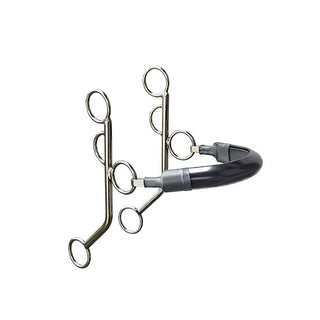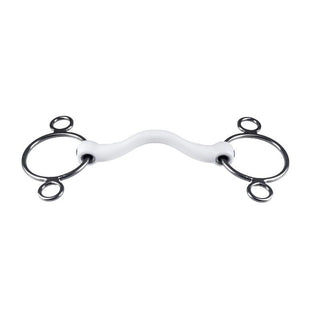We often get the question which mouthpiece is best for your horse. That's not such a crazy question, because mouthpieces come in all shapes and sizes. Because it is impossible to discuss all mouthpieces in detail, in this blog I will explain a bit more about the two most commonly used mouthpieces: the single-jointed mouthpiece and the double-jointed mouthpiece. I would also like to tell you more about other mouthpieces that give a good result. Together we look for the best bit for your horse.
Your horse's mouthpiece
To start with: what is a mouthpiece in horses? Perhaps a bit of an open door, but it is still good to clarify what we are talking about. The mouthpiece is the part of the bit that your horse has in his mouth. The mouthpiece therefore plays an important role in the way in which the rider controls his or her horse. As mentioned, the single-jointed and the double-jointed mouthpiece are most commonly used. Let's discuss them one by one.
Would you like to know more about bits such as the water ring snaffle, bust snaffle and D snaffle bit? Then read our blog:
What is the difference between a water ring snaffle, bust snaffle and D snaffle bit?
The double-broken mouthpiece
A double-broken bit is connected in two places, so that you actually get 3 parts. The middle part is on the tongue. As a result, this bit has a sharper effect on the tongue and friendlier on the layers and the corners of the mouth. This mouthpiece works especially well if your horse gives more counter pressure with his tongue because the pressure on the tongue will cause him to give less counter pressure and retract his chin. An example of a double-jointed mouthpiece is the Trust double-jointed snaffle bit.

The single-broken mouthpiece
A single jointed mouthpiece is known as the nutcracker effect bit. This nickname has wrongly given this mouthpiece a negative charge. Most single-joint bits nowadays are really more anatomically shaped so that the pressure is distributed more evenly. Compared to a double-jointed bit, however, this bit does give more pressure on the layers and the corners of the mouth, but the pressure on the tongue is not such that it is stuck, as it were, as in a nutcracker. Yet that is something many people think. A single jointed bit is often a good choice for horses that hang on the hand. Thanks to the pressure distribution on the tongue, layers and corners of the mouth, the horse will raise its head. An example of a single-jointed mouthpiece is the Trust single-jointed snaffle bit.
Successful mouthpieces without sharpness
The medium port or happy tongue bits have a slightly curved mouthpiece. It's a mouthpiece with no breaks, so basically it's a rod with an arc in it. The shape of the mouthpiece is such that it leaves the tongue freer and only exerts light pressure on it. The layers and the corners of the mouth also receive minimal pressure. This really makes this an ideal bit for horses with a sensitive tongue.
Locked single broken
A single-broken bit with a locked action prevents the single-broken bit from possibly exerting too much pressure on the tongue. This is because the bit can only bend up to a certain point and, as it were, locks when too much pressure is applied. As a result, this bit gives less pressure on the tongue than a standard single-jointed bit. The effect is therefore a bit softer than its unlocked brother. The layers also get less pressure and the bit cannot squeeze at the corners of the mouth.

Dr. Bristol
A dr. Bristol is a double-jointed bit, but with a plate in the middle that is placed at an angle of 45 degrees to the outer parts. This ensures that more pressure is applied to the tongue when the horse raises its head. The layers and corners of the mouth get a light pressure with this mouthpiece. This bit is a good alternative if your horse with a broken ankle bit quickly raises its head.
Segundo mouthpiece
The segundo mouthpiece quickly looks a bit unusual, but this is also an excellent bit that is friendly to the tongue, layers and corners of the mouth. This bit is also double jointed and features a high tongue recess. It releases the tongue and therefore distributes the pressure well over the tongue, layers and corners of the mouth. This is a perfect bit for horses that like to throw their tongue over the bit. It is also difficult for a horse to hang on this bit because of the moving parts. Horses remain lighter in contact with the hand on this bit.
Help with finding the best mouthpiece
We are happy to help you find the most suitable mouthpiece for your horse. Are you not satisfied with the information in this blog? Then visit our store or contact us. In cases we can help you in a few steps to find a mouthpiece that is completely suitable for your horse.










